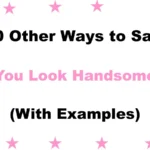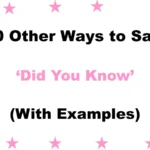Finding the right words to communicate clearly and kindly is essential, especially when you want to confirm plans, ideas, or proposals with someone. Saying “Please let me know if this works for you” is polite, but sometimes you may want to express the same thought in a way that feels more personal, warm, or professional depending on your relationship with the recipient.
Using alternatives can help your message stand out, feel more genuine, and foster better communication. In this article, you will find 30 thoughtful ways to say this phrase, each with explanations, examples, and advice on when and how to use them, helping you connect with your audience more effectively.
What Does “Please Let Me Know if This Works for You” Mean?
“Please let me know if this works for you” is a polite and respectful phrase used to seek someone’s confirmation, approval, or feedback on a proposed plan, time, or idea. It shows that you value the other person’s input and want to ensure that what you’re suggesting aligns with their availability, preferences, or expectations.
When to Use “Please Let Me Know if This Works for You”
Use this phrase when you want to:
- Confirm if a plan, date, or idea is suitable.
- Encourage open communication and feedback.
- Show respect for the recipient’s opinion and schedule.
Is It Professional/Polite to Say “Please Let Me Know if This Works for You”?
Yes, it is generally considered polite and professional. It’s a respectful way to ask for input without imposing. The tone is soft and collaborative, making it suitable for workplace communication as well as personal messages.
Pros and Cons of Saying “Please Let Me Know if This Works for You”
Pros:
- Shows respect and openness.
- Encourages a clear response.
- Maintains a polite tone.
Cons:
- Can sometimes feel repetitive or formal in casual contexts.
- May come across as vague if overused.
- Could be improved by adding more warmth or specificity depending on context.
Synonyms for “Please Let Me Know if This Works for You”
- Does this work for you?
- Let me know if this suits you.
- Would this be okay with you?
- Please confirm if this fits your schedule.
- Let me know your thoughts on this.
- Is this convenient for you?
- Please tell me if this arrangement works.
- Would this time be good for you?
- Can you please confirm if this is acceptable?
- Let me know if this matches your needs.
- Is this agreeable to you?
- Please advise if this works.
- Would this option work for you?
- Let me know if you’re comfortable with this.
- Does this timing suit you?
- Please let me know if this is okay.
- Are you okay with this plan?
- Let me know if you can make this work.
- Would this be suitable for you?
- Please confirm if this is feasible.
- Let me know if this meets your expectations.
- Is this arrangement suitable?
- Please inform me if this works on your end.
- Would you be alright with this?
- Does this fit into your schedule?
- Kindly let me know if this is acceptable.
- Let me know if this aligns with your plans.
- Would this be convenient for you?
- Please get back to me if this works.
- Is this okay from your side?
1. Does This Work for You?
Definition: A straightforward way to ask if a suggestion or plan is acceptable.
Detailed Explanation: This phrase is simple and direct, ideal for clear communication without extra formality.
Scenario Examples: Asking a colleague if a meeting time fits their schedule.
Best Use: Casual or semi-formal conversations where clarity is key.
Worst Use: Very formal or sensitive communications where softness is needed.
Tone: Direct and neutral.
2. Let Me Know if This Suits You
Definition: A polite way to ask if a plan or option fits the recipient’s preferences.
Detailed Explanation: Adds a tone of respect and flexibility to your request.
Scenario Examples: Emailing a client about proposed project dates.
Best Use: Professional settings or polite personal messages.
Worst Use: Too formal for very casual chats.
Tone: Polite and considerate.
3. Would This Be Okay with You?
Definition: Seeks approval or consent in a gentle manner.
Detailed Explanation: This phrase softens the request, making it less demanding and more collaborative.
Scenario Examples: Proposing a change to a plan to a friend.
Best Use: Informal to semi-formal contexts.
Worst Use: When a firm yes/no answer is required quickly.
Tone: Friendly and cooperative.
4. Please Confirm if This Fits Your Schedule
Definition: A polite and professional request for scheduling confirmation.
Detailed Explanation: Emphasizes the importance of timing and encourages the recipient to check their availability.
Scenario Examples: Arranging a business meeting or appointment.
Best Use: Formal professional communication.
Worst Use: Informal texts or messages.
Tone: Formal and respectful.
5. Let Me Know Your Thoughts on This
Definition: Invites feedback beyond a simple yes or no.
Detailed Explanation: Opens the door for discussion or suggestions, showing that you value the recipient’s opinion.
Scenario Examples: Sharing a proposal with a team member or friend.
Best Use: Collaborative situations where input is welcome.
Worst Use: When you only need a simple confirmation.
Tone: Open and inviting.
6. Is This Convenient for You?
Definition: Asks about suitability with a focus on ease and comfort.
Detailed Explanation: Shows awareness of the other person’s comfort and preferences.
Scenario Examples: Scheduling calls or meetings.
Best Use: Polite and professional contexts.
Worst Use: Casual conversations where this might sound too formal.
Tone: Respectful and thoughtful.
7. Please Tell Me if This Arrangement Works
Definition: A formal way to seek approval of a proposed plan.
Detailed Explanation: Useful when confirming detailed plans or agreements.
Scenario Examples: Organizing event details with clients or vendors.
Best Use: Formal business communications.
Worst Use: Casual or informal chats.
Tone: Formal and clear.
8. Would This Time Be Good for You?
Definition: A friendly question about timing suitability.
Detailed Explanation: Makes scheduling sound relaxed and open to changes.
Scenario Examples: Setting up meetings or appointments with friends or coworkers.
Best Use: Semi-formal and casual settings.
Worst Use: When a strict confirmation is necessary.
Tone: Casual and friendly.
9. Can You Please Confirm if This Is Acceptable?
Definition: A formal request for approval or acceptance.
Detailed Explanation: Ensures clarity and accountability in professional communication.
Scenario Examples: Confirming contract details or agreements.
Best Use: Business emails and official correspondence.
Worst Use: Informal or personal messages.
Tone: Formal and authoritative.
10. Let Me Know if This Matches Your Needs
Definition: Checks if a proposal or offer aligns with the recipient’s requirements.
Detailed Explanation: Useful when offering customized solutions or options.
Scenario Examples: Customer service communications or consulting.
Best Use: Professional and service-oriented contexts.
Worst Use: Casual or social situations.
Tone: Helpful and attentive.
11. Is This Agreeable to You?
Definition: A polite way to ask if something is acceptable or satisfactory.
Detailed Explanation: Slightly formal, suitable for agreements and decisions.
Scenario Examples: Confirming terms in meetings or discussions.
Best Use: Formal meetings and negotiations.
Worst Use: Casual conversations.
Tone: Formal and respectful.
12. Please Advise if This Works
Definition: A brief, professional way to request confirmation or feedback.
Detailed Explanation: Common in emails to prompt a response without sounding demanding.
Scenario Examples: Business correspondence.
Best Use: Professional and formal communication.
Worst Use: Informal texts or chats.
Tone: Professional and succinct.
13. Would This Option Work for You?
Definition: Offers a choice and asks for acceptance.
Detailed Explanation: Shows flexibility and willingness to accommodate preferences.
Scenario Examples: Proposing different project plans or meeting times.
Best Use: Collaborative and client-facing settings.
Worst Use: When only one option is available.
Tone: Flexible and considerate.
14. Let Me Know if You’re Comfortable with This
Definition: Checks for comfort and acceptance, especially important in sensitive situations.
Detailed Explanation: Shows empathy and respect for personal boundaries.
Scenario Examples: Discussing changes affecting a team member’s workload.
Best Use: Sensitive or personal communication.
Worst Use: Routine or formal business messages.
Tone: Empathetic and caring.
15. Does This Timing Suit You?
Definition: Politely asks if a specific time is convenient.
Detailed Explanation: A slightly formal way to confirm scheduling.
Scenario Examples: Planning meetings or appointments.
Best Use: Professional settings.
Worst Use: Very casual contexts.
Tone: Polite and formal.
16. Please Let Me Know if This Is Okay
Definition: Simple and direct request for approval or confirmation.
Detailed Explanation: Works well in everyday communication with friends or colleagues.
Scenario Examples: Asking if a plan or suggestion is acceptable.
Best Use: Informal to semi-formal conversations.
Worst Use: Formal communications requiring detailed feedback.
Tone: Friendly and clear.
17. Are You Okay with This Plan?
Definition: Casual way to check acceptance.
Detailed Explanation: Emphasizes collaboration and shared decision-making.
Scenario Examples: Team discussions or friend groups planning events.
Best Use: Informal and friendly environments.
Worst Use: Formal or client communications.
Tone: Casual and conversational.
18. Let Me Know if You Can Make This Work
Definition: Friendly and slightly informal request for confirmation.
Detailed Explanation: Implies flexibility but seeks commitment.
Scenario Examples: Coordinating schedules with friends.
Best Use: Casual or semi-formal contexts.
Worst Use: Formal business emails.
Tone: Warm and inviting.
19. Would This Be Suitable for You?
Definition: Polite, formal inquiry about acceptability.
Detailed Explanation: Focuses on appropriateness and convenience.
Scenario Examples: Professional proposals or client interactions.
Best Use: Formal and business contexts.
Worst Use: Informal chats.
Tone: Respectful and formal.
20. Please Confirm if This Is Feasible
Definition: Requests a practical confirmation regarding possibility.
Detailed Explanation: Often used in project planning or logistics.
Scenario Examples: Checking if a timeline or resource allocation works.
Best Use: Business and technical communications.
Worst Use: Casual conversations.
Tone: Professional and precise.
21. Let Me Know if This Meets Your Expectations
Definition: Checks if a proposal aligns with what the recipient hopes for.
Detailed Explanation: Useful for service providers or customer relations.
Scenario Examples: After delivering a draft or service proposal.
Best Use: Professional and client-facing communication.
Worst Use: Informal exchanges.
Tone: Professional and attentive.
22. Is This Arrangement Suitable?
Definition: Formal question regarding acceptability of a plan or setup.
Detailed Explanation: Common in negotiations and formal settings.
Scenario Examples: Organizing partnerships or events.
Best Use: Formal business contexts.
Worst Use: Casual or informal use.
Tone: Formal and polite.
23. Please Inform Me if This Works on Your End
Definition: Formal request for confirmation, often used in technical or business contexts.
Detailed Explanation: Implies both parties have to agree or align.
Scenario Examples: IT support or remote collaborations.
Best Use: Professional communication involving coordination.
Worst Use: Casual conversation.
Tone: Formal and clear.
24. Would You Be Alright with This?
Definition: Gentle way to check for acceptance or comfort.
Detailed Explanation: Shows empathy and sensitivity.
Scenario Examples: Discussing sensitive changes with colleagues or friends.
Best Use: Personal or sensitive situations.
Worst Use: Formal business proposals.
Tone: Warm and considerate.
25. Does This Fit into Your Schedule?
Definition: Politely asking about timing compatibility.
Detailed Explanation: Emphasizes respect for the recipient’s availability.
Scenario Examples: Scheduling meetings or appointments.
Best Use: Professional and polite contexts.
Worst Use: Informal chats.
Tone: Respectful and formal.
26. Kindly Let Me Know if This Is Acceptable
Definition: Polite, formal request for confirmation.
Detailed Explanation: Adds a courteous tone to the request.
Scenario Examples: Formal emails or letters.
Best Use: Business or official communication.
Worst Use: Casual messages.
Tone: Courteous and formal.
27. Let Me Know if This Aligns with Your Plans
Definition: Checks if the proposal fits into the recipient’s broader schedule or objectives.
Detailed Explanation: Shows awareness of the recipient’s priorities.
Scenario Examples: Project management or collaborative planning.
Best Use: Professional and collaborative contexts.
Worst Use: Informal or personal conversations.
Tone: Thoughtful and professional.
28. Would This Be Convenient for You?
Definition: Asks about ease and comfort in a polite way.
Detailed Explanation: Focuses on making things easier for the recipient.
Scenario Examples: Setting meeting times or delivery dates.
Best Use: Professional and polite situations.
Worst Use: Informal chats.
Tone: Respectful and thoughtful.
29. Please Get Back to Me if This Works
Definition: Requests a timely response confirming acceptance.
Detailed Explanation: Slightly more urgent but still polite.
Scenario Examples: Business follow-ups or urgent planning.
Best Use: Professional contexts needing prompt feedback.
Worst Use: Casual conversations.
Tone: Polite with a hint of urgency.
30. Is This Okay from Your Side?
Definition: Informal way to check acceptance or agreement.
Detailed Explanation: Used for quick confirmation, often in conversations.
Scenario Examples: Chats with colleagues or friends.
Best Use: Informal or semi-formal settings.
Worst Use: Formal communication.
Tone: Casual and friendly.
Conclusion
Using alternatives to “Please let me know if this works for you” helps you express yourself more thoughtfully and clearly. Each phrase carries its own nuance, tone, and level of formality, so choosing the right one depends on your relationship with the recipient and the context.
Whether you want to sound professional, warm, or casual, these 30 options give you flexibility to connect in a way that feels genuine and respectful. Remember, clear and kind communication always strengthens relationships and encourages positive responses.
FAQs
1. What’s the most professional alternative to “Please let me know if this works for you”?
A strong professional alternative is “Please confirm if this fits your schedule” or “Kindly advise if this works on your end.” These phrases maintain a polite tone while sounding clear, formal, and respectful—ideal for business settings or client-facing communication.
2. Can I use “Let me know if this works for you” in a formal email?
Yes, but with slight refinement. While it’s polite and respectful, consider using a more formal variation like “Please confirm if this arrangement is suitable” or “Kindly advise at your earliest convenience.” These alternatives ensure your message sounds more professional and polished.
3. How do I make my message sound less pushy when asking for confirmation?
Use gentle and open-ended phrases like:
- “Let me know your thoughts on this.”
- “Would this time be convenient for you?”
These choices make your message sound collaborative rather than demanding, while still encouraging a response.
4. Are there any informal or friendly alternatives I can use with close colleagues or friends?
Absolutely! Try “Does this work for you?”, “Are you okay with this plan?”, or “Let me know if you can make this work.” These options are perfect for more casual or friendly conversations where warmth and ease matter more than formality.
5. Why is it important to have alternatives for phrases like “Please let me know if this works for you”?
Using varied language helps your message feel more personalised, engaging, and human. It prevents your writing from becoming repetitive and shows that you’re being intentional and thoughtful with your words—whether you’re speaking to a friend, coworker, or client.

Mia Rose is a passionate Language Coach and Contributor at GrammarPeaks, where she specializes in practical grammar tips and language learning strategies. With a strong foundation in education and communication, Mia brings a friendly, approachable style to her writing. Her goal is to make complex grammar rules simple and usable for learners at any level, helping them grow in both confidence and fluency.





